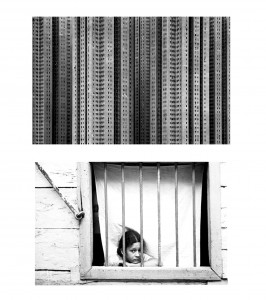“Can we really retreat into self-contained boxes without losing something of the essence of being human?”
Starting from the analysis of the whole and ending up to the particular that is how Rudofsky analyzes the conditions under which the man, specifically the Anglo-Saxon culture, relates intself to the environment in the broadest sense (“The Conditioned Outdoor Room” extracted from the script “Behind the Picture Window”).
Here the Austrian architect consider the history, causes and consequences of the estrangement of the modern-man and his way of living from what he calls the “outdoor room”, that is the missing link between private life and man’s relationship with nature, implicitly criticizing the ideas of order and rationalism of modern architecture.
Interesting is the comparison, in uses and designs, between the ancient Roman peristylium or Japanese gardens and the idea of Anglo-Saxon garden, defined as “un-occupied space”.
In the first examples, nature has a more poetic and a first contact with the “room-mates”, it still being managed by man (“That reverted to indoor outdoor”). It does not happen for the second one, where the garden is a resulting space between houses or a buffer between public space and private area.
At the end, a reflection on that archetype element, such as the wall, considered primarily as a symbol of the tree. The two elements despite being of a different nature, live in a symbiosis of metaphors: sculpture, shadows and reflections, screening, barrier …
The wall as an object full of potential: confidentiality, boundary, separation, window, density / climate utility, density / light …
“The ego as knowledge cannot be understood unless it starts from the exploration of others as knowledge. In this sense, the other is one of the faces of the ego, its possibility still unexpressed, a form of its entity.” Adonis
In the ensuing discussion in the auditorium, through the analysis of the various texts, we have been spoken of the role, and most importantly, of relationships that humans have with its surroundings, architectural and even more. We speculated on the meaning of ENVIRONMENT, on how to change the spaces and how and what we are affected depending on these changes. We talked about the “CHAOS” and the ideological confusion that modern-thinking led to generations of architects, the loss of cultural roots and about a “human (soul) scale” vision of a better world.
POSSIBLE PERSONAL RESEARCH:
“For those who pass it without entering, the city is one thing; it is another for those who are trapped by it and never leave. There is the city where you arrive for the first time; and there is another city which you leave never to return. Each deserves a different name…” I. Calvino
Talking about the “future” I think that “in a certain present there is more of the future than in the future itself”, but at the same time that the present we live is not sustainable for the world we inhabit.
It makes me think about a question: is the Rural life extinct, as a model?
And at the same time: can we really retreat into self-contained boxes without losing something of the essence of being human?
“What is the city for us today? I think I have written something like an ultimate love poem to the cities, at the time that it has become increasingly difficult to live them as a cities.” I. Calvino, March 1983 – Columbia University (New York)
I strongly believe that we can solve this Platonic dualism that the modern man brings with himself far too long. We have to compromise with ourselves and decide the priorities to be tackled: City-Nature-Chaos.
Suggestion: http://www.youtube.com/watch?v=7ofMw11B1P8

